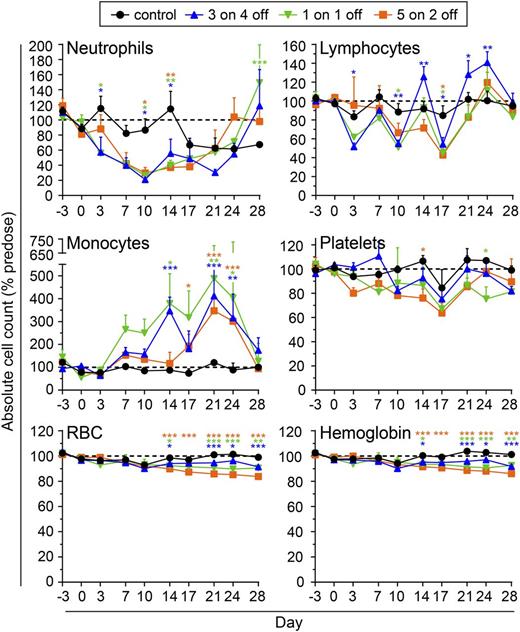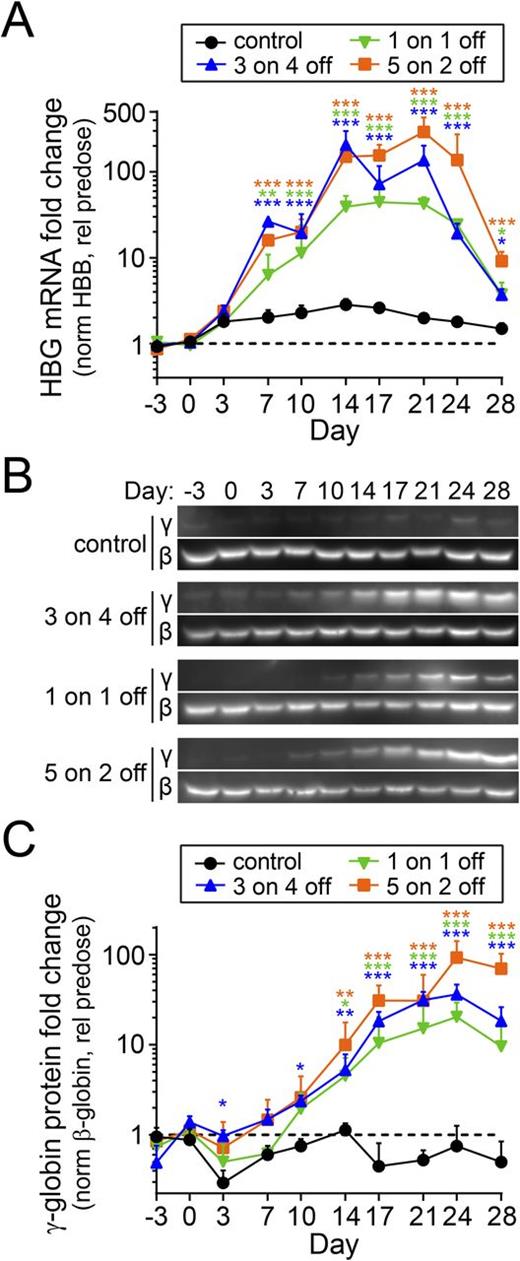Abstract
HBG protein, when paired with α-globin, forms fetal hemoglobin (HBF). HBF can substitute for defective adult hemoglobin found in sickle cell disease and β-thalassemia patients to ameliorate disease. We have previously shown that ACY-957, a selective inhibitor of HDAC1/2, induces HBG mRNA and HBF protein in vitro. We have also shown that 5 days of oral dosing with ACY-957 induces HBG mRNA in the blood of non-anemic cynomolgus monkeys. In this work, we used this model to investigate the effects of ACY-957 over an extended dosing period and with several dosing schedules. We have also developed new assays for PD response and HBG protein induction, a predictor of efficacy.
We selected a dose of 75 mg/kg based on previous studies. 15 naïve, male monkeys, ~3.5 years in age and ~3.5 kg in weight were randomized into four groups and dosed QD x 5 per week (starting on day 0) for 3 weeks followed by a 10 day washout period (Fig 1A): 'Control' = vehicle days 0, 1, 2, 3, 4; '3 on 4 off' = ACY-957 days 0, 1, 2 and vehicle days 3, 4; '1 on 1 off' = ACY-957 days 0, 2, 4 and vehicle days 1, 3; '5 on 2 off' = ACY-957 days 0, 1, 2, 3, 4. Blood samples were collected pre-dose on days 0 and 3 every week. There were no notable clinical observations during the study. A minor, yet significant, body weight reduction was observed in all groups (Fig 1B). Body weight loss was less in the 3 on 4 off group, and unlike the 1 on 1 off and 5 on 2 off groups, these animals recovered to control levels following the washout period.
For all groups, plasma levels of ACY-957 were 2 μM at 24 hr post-dose (Fig 1C). Prior to the next week of dosing, the 1 on 1 off and 5 on 2 off groups had plasma levels of 250 nM, while the 3 on 4 off group had background levels. These findings confirm the target exposure was reached and suggest that ACY-957 does not accumulate with extended dosing. Acetylation of histone H3 lysine 56 (H3K56ac) in nucleated peripheral blood cells was used as a marker of PD response (Fig 1D-E). H3K56ac steadily increased throughout the study in all treatment groups. H3K56ac trended towards baseline levels during the washout period, yet elevated levels persisted in 3 on 4 off and 5 on 2 off groups for up to 144 hours after the last dose. Furthermore, 3 on 4 off dosing yielded a PD response equivalent to 5 on 2 off and superior to 1 on 1 off dosing. These data reveal that the PD response is decoupled from the dosing schedules examined, a finding consistent with the slow off rate of aminobenzamide HDAC inhibitors.
Complete blood counts (CBC) were affected in all groups (Fig 2). Neutrophils were suppressed by 70%, with nadir reached after 2 weeks of dosing and a rapid return to control levels during the washout period. Lymphocytes were cyclically suppressed by 50% at day 3 of each week, returning to baseline levels prior to the next week of dosing. Monocytes were elevated 4-fold by the third week of dosing and returned to control levels during the washout period. Platelets dropped by 20% in the 5 on 2 off group only, returning to control levels during the washout period. Red blood cells (RBC), hemoglobin, and hematocrit levels decreased by 15% in the 5 on 2 off group, an effect minimized in the 3 on 4 off and 1 on 1 off groups.
HBG mRNA induction was observed in all groups and correlated with PD response over time (Fig 3A). HBG mRNA increased a maximum of 50-fold in the 1 on 1 off group and 200-fold in the 3 on 4 off and 5 on 2 off groups. As a percentage of all β-like globin mRNA, HBG increased from ~0.01% at baseline to ~1% at peak response. HBG protein was also elevated, reaching levels of 20-, 35-, and 90-fold above baseline in the 1 on 1 off, 3 on 4 off, and 5 on 2 off groups, respectively (Fig 3B-C). HBG mRNA trended to control group levels during the washout period, while HBG protein remained elevated, a finding consistent with the transient lifespan of RNA containing reticulocytes and the long lifespan of the protein containing RBC.
In conclusion, we have extended our previous results by showing that 3 week dosing of ACY-957 is well-tolerated and leads to an accumulation of HBG protein in monkey. Furthermore, we have established the relationship between PK, PD, hematopoietic toxicity, and potential efficacy for ACY-957. 3 on 4 off dosing elicited a PD response and HBG induction profile comparable to 5 on 2 off dosing, while minimizing body weight loss and hematopoietic toxicity. Our findings suggest that dose level and schedule may be further refined to optimize the therapeutic window of HDAC1/2-selective inhibitors for hemoglobinopathies.
Chonkar:Acetylon Pharmaceuticals, Inc.: Employment, Equity Ownership. Jarpe:Acetylon Pharmaceuticals, Inc.: Employment, Equity Ownership. Bhol:Acetylon Pharmaceuticals, Inc.: Employment, Equity Ownership. Jones:Acetylon Pharmaceuticals, Inc.: Employment, Equity Ownership. Shearstone:Acetylon Pharmaceuticals, Inc.: Employment, Equity Ownership.
Author notes
Asterisk with author names denotes non-ASH members.




This feature is available to Subscribers Only
Sign In or Create an Account Close Modal